Look no further, you’ve found the best easy, foolproof recipe for tender, buttery, and perfect scones, ready in just 30 minutes! My recipe includes plenty of tips and tricks as well as a detailed video tutorial. Includes notes on how to add your favorite mix-ins like fruit, chocolate, or nuts, too!
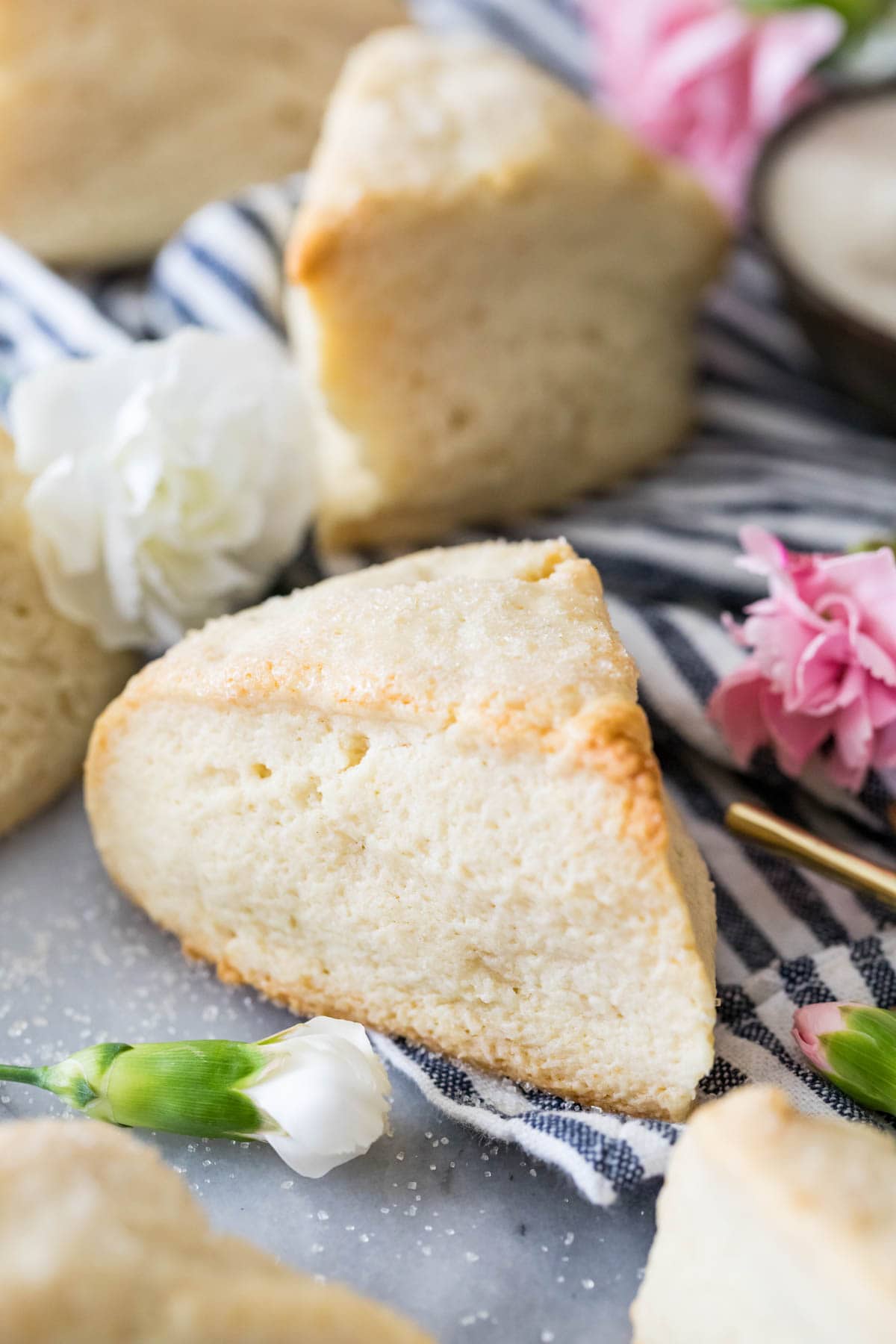
A Simple, Classic Scones Recipe
This quick and easy scone recipe makes flavorful, beautifully textured scones without any fuss. It comes together in minutes in a food processor (easy clean-up!) and yields professional, tea-party worthy results every time. They taste terrific plain, but can also be dressed up with add-ins or a sprinkle of sugar or a smear of jam.
If you’ve been too intimidated to make this wedge shaped treat in the past, you won’t be after trying my scone recipe. You’ve got this!
Why you’ll love this recipe:
- No pastry cutter needed! Instead we’ll use a food processor, which does all of the heavy lifting without overworking the dough. Note: I do also provide instructions for how to make them with a pastry cutter or grater, if you don’t have a food processor.
- Completely customizable. Frozen fruit (or fresh fruit, it’s just a bit messier), chocolate chips, dried fruit, nuts, or citrus zest are all great options. I’ve used this recipe for lots of different flavor variations such as my lemon poppy seed scones, chocolate scones, raspberry scones, and more! You can also omit the sugar and make a savory version–yum!
- No eggs. This is no accidental omission. I found that using eggs makes for less flaky and less melt-in-your-mouth results.
- Flaky, tender layers, thanks to a little laminating. This process is easy, and it’s great practice for when you want to try making biscuits or puff pastry 😉
What You Need
One of the best things about my scones recipe is that it uses basic ingredients that you probably already have on hand.
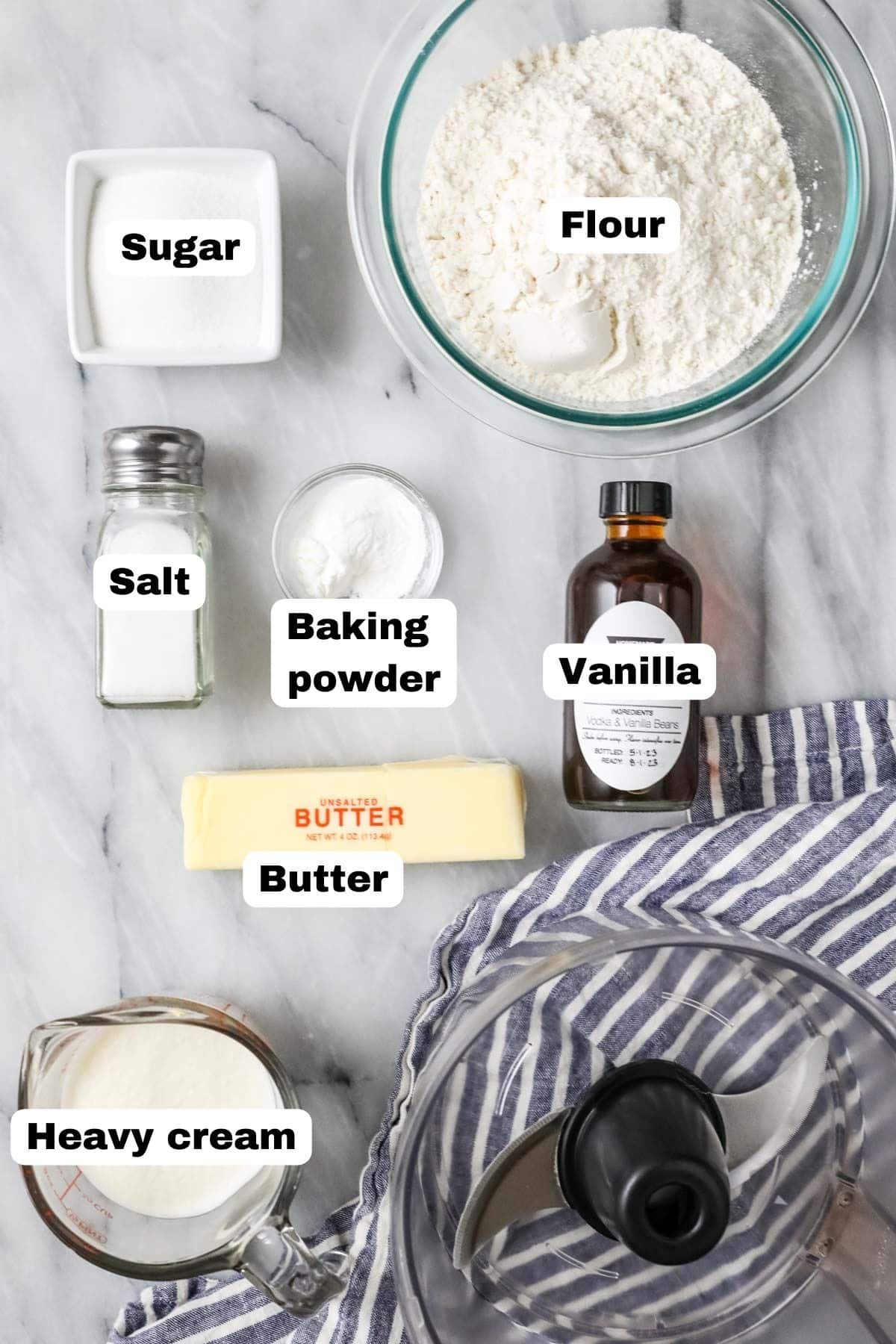
- Butter. Keep your butter as cold as possible, as cold butter pieces distributed throughout the dough makes for tender, flaky, and buttery layers! I like to freeze my butter for at least 15-30 minutes (or longer) before I begin.
- Flour. Do NOT use self-rising flour or your scones will become much too tall and tip over. Stick with regular, all-purpose flour (“plain flour” in the UK).
- Heavy cream. This helps bind everything together, much like an egg would, but the results are much more melt-in-your-mouth. Make sure to keep this nice and cold too!
- Sugar. A small amount adds sweetness, but not so much that you can’t add a vanilla glaze or sweet add-ins. I also add a splash of vanilla extract. You can omit or reduce these if you are making savory scones.
- Add-ins. These scones are great plain, but if you’d like, you can add chocolate chips, nuts, frozen fruit (fresh can get messy), etc. Cheddar cheese is a great addition for a savory version! Note that making this recipe with add-ins, especially moist add-ins like fruit, will result in a slightly longer bake time.
SAM’S TIP: If you can get your hands on it, I recommend using a high quality European butter in this scone recipe. It has a higher fat content and makes for especially delectable, tender results.
How to Make Scones
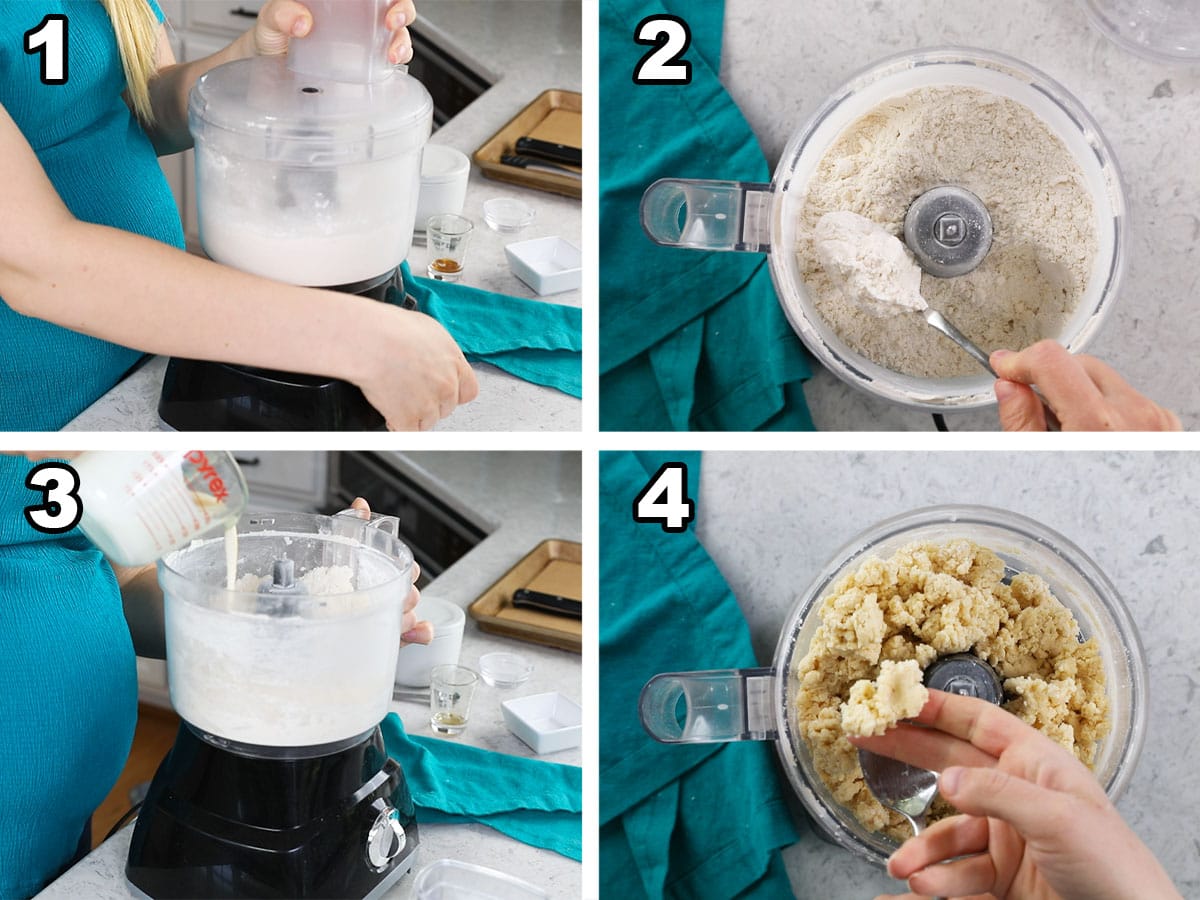
- Pulse the dry ingredients together in your food processor.
- Add the butter pieces and pulse until incorporated; the butter pieces should be no larger than a chocolate chip at this point.
- Pour the cream and vanilla over the butter mixture.
- Pulse until your dough starts to clump together. You can test this by pinching some dough between your fingers–if it clings together, it’s ready!
It’s important to note that you should be pulsing the ingredients in brief spurts and not simply blending. Pulsing make sure everything gets evenly distributed. If you just blend everything, it won’t incorporate evenly and the batter will get too wet, too warm, and over-worked.
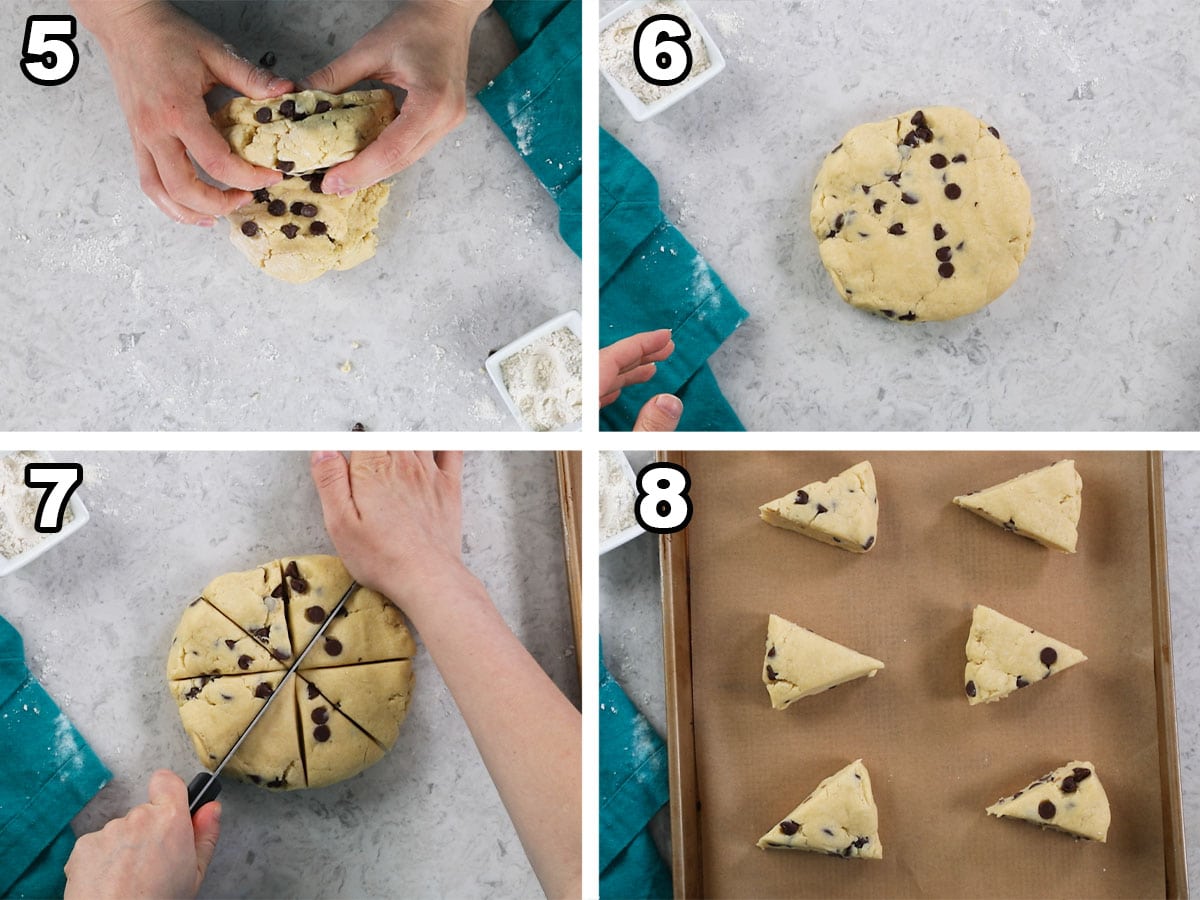
- Lamination: Turn your dough out onto a floured surface. Sprinkle any add-ins overtop, if using, and form it into a disc. Fold the dough over itself (add more add-ins here if desired), flatten, rotate 90 degrees, and repeat. Do this process about 5 times total.
- Form your dough into a disc that is about 1″ thick and 6″ wide. Avoid over-handling your dough and don’t warm it up too much, or your scones could become flat and dense. The disc doesn’t need to be super smooth.
- Cut the disc into wedges, pressing straight down with a sharp knife–do NOT saw! If you do, then your scones may tip over in the oven or have messy edges.
- Place the scones on your baking sheet, brush them with cream, and sprinkle with sugar. Bake until light golden brown and let cool slightly before enjoying.
SAM’S TIP: If your dough gets too warm during the lamination process, you can pop your scones in the freezer for 10-15 minutes before baking. It’s very important that your dough stays nice and cold!
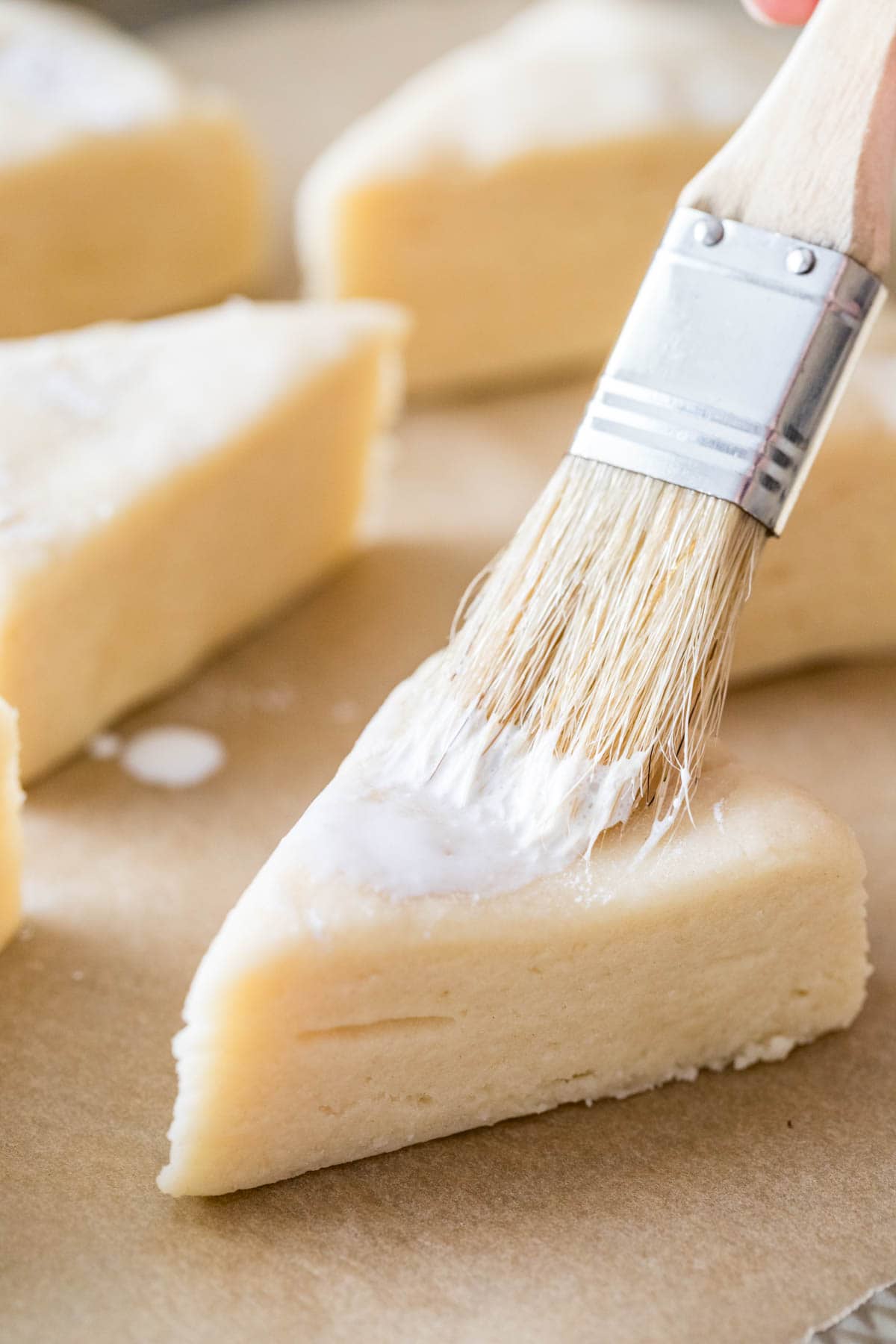
Frequently Asked Questions
You can use a grater or a pastry cutter to cut the butter into the flour instead; however, your dough will be very dry and will require more effort to come together. I provide more detailed instructions for this in the recipe below.
Yes! To do this, prepare your dough as instructed, then wrap in cling wrap (or place in an airtight container) and store in the refrigerator for up to 3 days or in the freezer for up to 3 months.
If baking from the refrigerator, you can follow the recipe as written. If baking from frozen, the scones may need a few extra minutes in the oven. I always wait until just before baking before brushing them with cream and sprinkling with sugar.
Yes! To freeze baked scones, let them cool completely after baking. Once they’ve cooled, transfer them to an airtight container (I like to loosely wrap each scone in wax paper or parchment paper so they don’t stick together) and enjoy within 3 months.
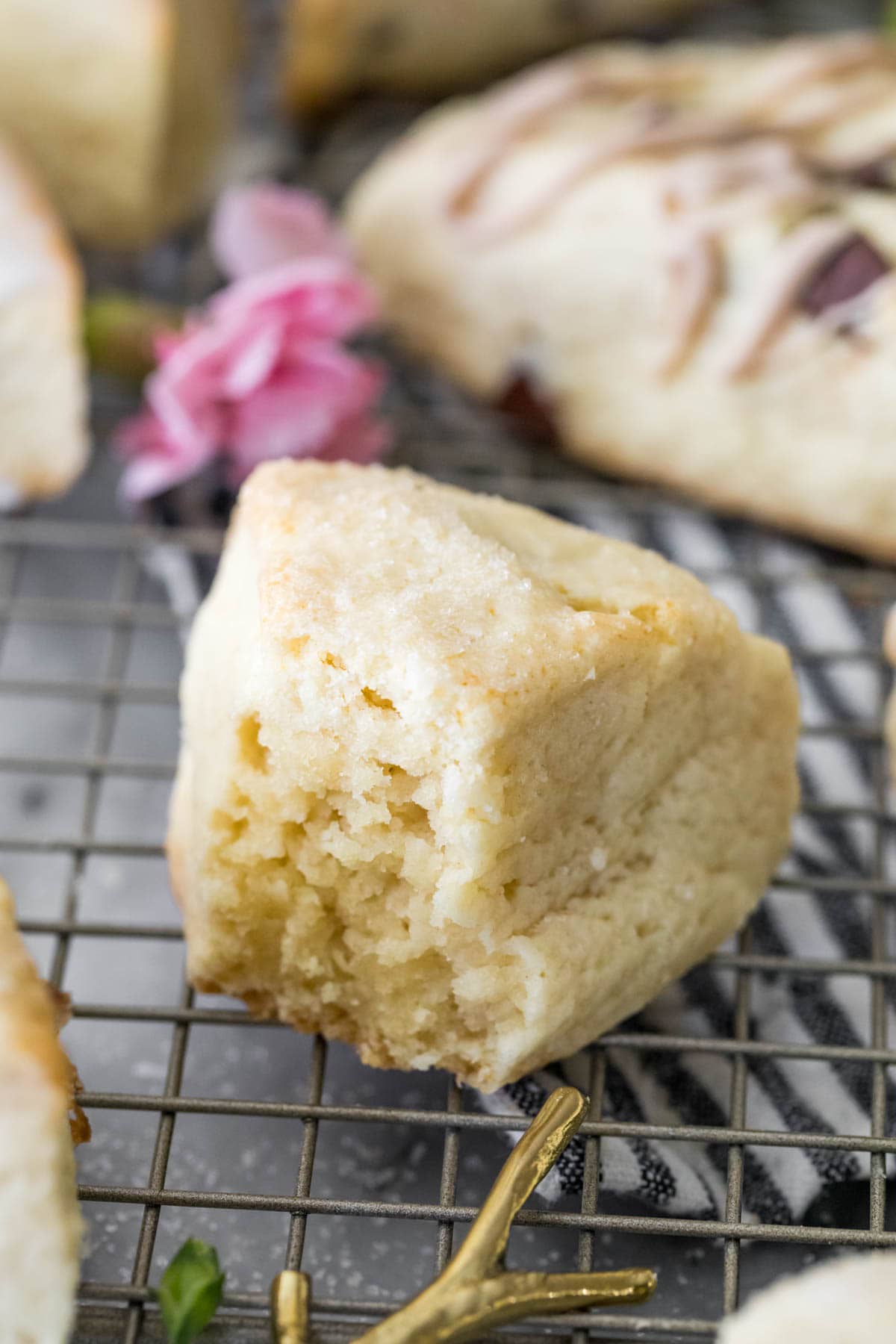
This scones recipe is tasty enough to be served plain, but a little honey butter, strawberry sauce, or whipped cream on the side never hurts!
Enjoy!
Let’s bake together! Subscribe to my newsletter to be notified of all the newest recipes, and find my free recipe tutorials on YouTube 💜
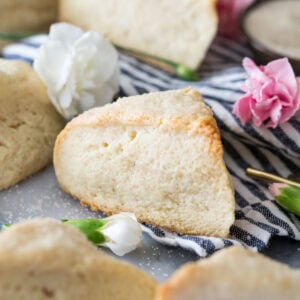
Scones
Ingredients
- 2 cups (250 g) all-purpose flour
- ¼ cup (50 g) granulated sugar
- 2 teaspoon baking powder
- ½ teaspoon salt
- ½ cup (113 g) very cold unsalted butter I like to place my butter in the freezer 15 minutes before beginning to ensure it is cold
- ½ cup (120 ml) heavy cream
- ¼ teaspoon vanilla extract
- ½ cup add-ins optional: frozen berries, chocolate chips, nuts, etc.
- Additional heavy cream for brushing over scones optional
- Additional sugar for sprinkling over scones optional
Recommended Equipment
Instructions
- Preheat your oven to 375F (190C) and line a baking sheet with parchment paper. Set aside.
- Combine flour, sugar, baking powder, and salt in the basin of a food processor and pulse to combine.2 cups (250 g) all-purpose flour, ¼ cup (50 g) granulated sugar, 2 teaspoon baking powder, ½ teaspoon salt
- Cut butter into Tablespoon-sized pieces and scatter over flour mixture, pulse until butter is cut up into the flour mixture and butter pieces are no longer visible.½ cup (113 g) very cold unsalted butter
- Combine the cream and vanilla extract in a measuring cup and pour heavy cream over your flour mixture.½ cup (120 ml) heavy cream, ¼ teaspoon vanilla extract
- Pulse until dough begins to clump together.

- Transfer dough to a lightly floured surface and (handling lightly, as you don’t want to over-work this dough) add any add-ins at this point, gently working them into the dough. Fold the dough in half over itself and use your hands to gently flatten layers together. Rotate the dough 90 degrees and fold in half again, repeating this step 5 times and taking care to not overwork the dough.½ cup add-ins
- Form the dough into a smooth disk about 1″ thick by 6″ round.
- Cut the disk into 8 wedges, pressing the knife straight down with each cut.

- Transfer wedges to prepared baking sheet and place about 2" apart. Brush lightly with cream and sprinkle with sugar.Additional heavy cream for brushing over scones, Additional sugar for sprinkling over scones
- Bake on 375F (190C) for 14-16 minutes or until edges are just beginning to turn golden brown. Don’t over-bake your scones or they will be dry and tough.
- Allow scones to cool on baking sheet before serving and enjoying.
Notes
¹Food Processor
If you don’t have a food processor you can make the scones by whisking together the flour, sugar, baking powder and salt. Cut the butter into the dry ingredients with either a pastry cutter, box grater, or pair of knives. Whisk together heavy cream and vanilla and pour over and stir until well-combined. The dough will be very dry but will come together with some effort. If absolutely necessary you can add a bit more cream, a splash at a time.Storing
Scones are best enjoyed fresh, but you can store in an airtight container at room temperature for up to 3 days. See the FAQ section in the post for instructions on freezing scones (before or after baking).How to Make Lemon Scones
Add 1 Tbsp of fresh lemon zest into the dough with the butter Once scones have cooled, dip in a simple glaze made of 1 ¼ cup (160g) powdered sugar, 1 ½ Tablespoons (20ml) lemon juice, 1 ½ teaspoons of water, and ¼ teaspoon of vanilla extract.Nutrition
Nutritional information is based on third-party calculations and should be considered an estimate only. Actual nutritional content will vary based upon brands used, measuring methods, cooking method, portion sizes, and more.
I originally published this recipe many years ago, but have just updated it as I thought it could use a new video and some updated tips and tutorial photos.

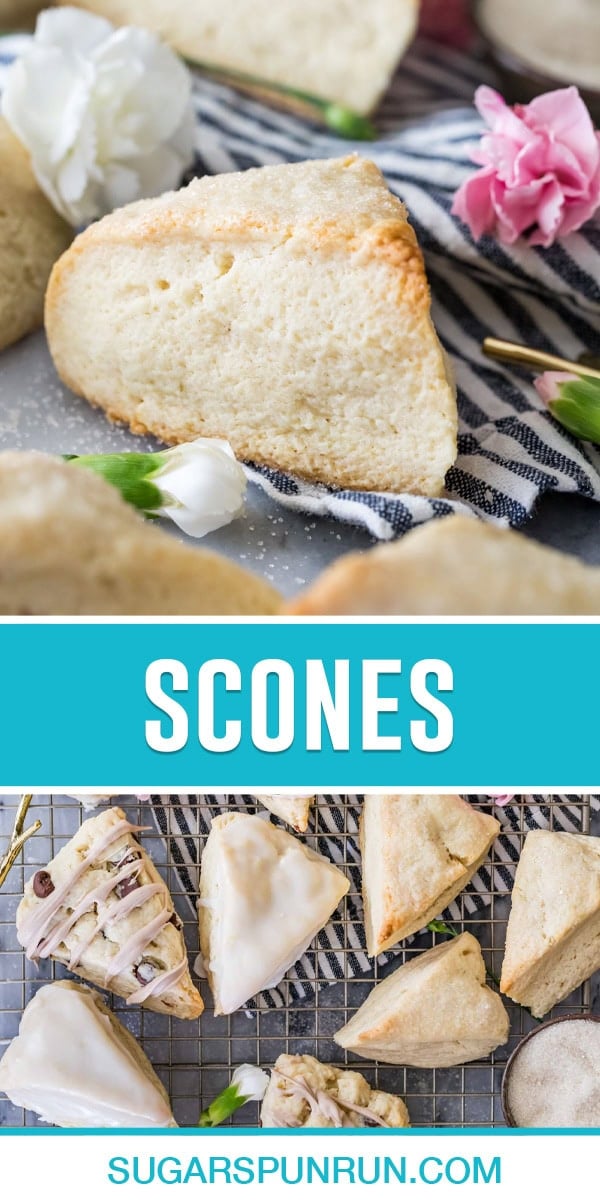
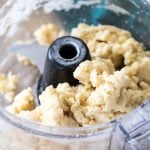


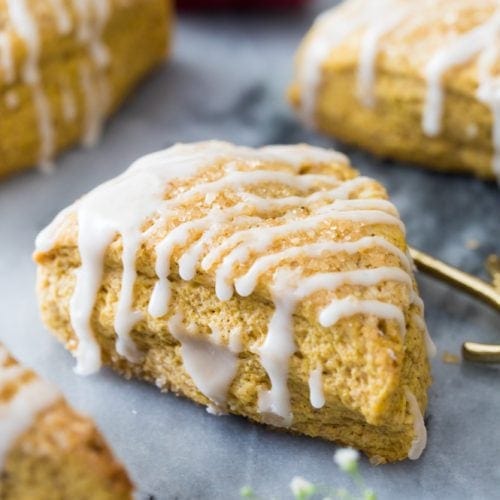
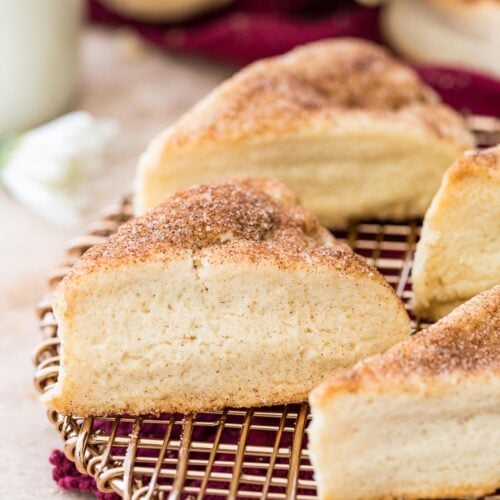





Jenn Selph
My favorite go to breakfast thank you for sharing I’ve been making these for like 8 plus years with your recipe.
Emily @ Sugar Spun Run
We are so happy to hear that, Jenn! Thanks for the review 🩷
Matt M
I only just started making scones last month, after getting a pastry cutter for Christmas. Tried a few recipes that resulted in mediocre scones (not bad for a first effort, but not outstanding). I just gave this recipe a try yesterday, using frozen mixed berries, and the lemon glaze from your Triple Berry Scone recipe, and it made some AMAZING scones. This will be my go-to from now on!
Denise
I don’t usually leave comments for recipes, but these are the BEST scones I have ever made. I used half and half because I made them in a whim and that’s what I had. also added in craisins. So light and fluffy, sweet and the perfect amount of dense. I cannot wait to have another with coffee tomorrow. Next time I might cut them smaller so they can last longer!
Sam
I’m so glad you enjoyed them so much, Denise! I appreciate you taking the time to leave a review. 🙂
P. Agusti
Delicious!!! I will make again and again. Thank you for putting this on the internet for our enjoyment. Cheers!
Michele
I make these with mini chocolate chips. They are perfect, every time.
Skye
Just made this & my apartment smells heavenly!! I did mini scones (half size) & found that 11-14 minutes worked well ☺️
Christine A Penney
Only recently discovered your page when looking for buttermilk pancakes. The best ever!!! I wondered if buttermilk would alter my waffle receipe and was thrilled to find this!. I wasn’t about to do any receipe that did not separate the yolks and whites so was doubly impressed that you promoted this tactic.
Great site, I will be visiting often and sharing with friends and family.
Happy new year
Best,
Christine
Sam
Thank you so much, Christine! I hope you love everything you try! Happy New Year! 🙂
Kat
10/10 great for a melt-in-your mouth scone!
Leslie
Can I use butter milk instead of Heavy cream?
Sam
Hi Leslie! That should work. 🙂
Kat
These scones are definitely the BEST! Better than the recipes that add egg, as that doesn’t give the texture of a good crumbly scone. This is my go-to!
Jean
I just made these for the first time and used food processor as indicated. The dough did not clump and had to keep adding more cream. Still was real stiff and there was no way I could laminate it. Fortunately, i pressed then into shape and baked. They turned out – OK.
Sam
Hi Jean! Hmm it should clump if you pulse it enough (assuming the flour wasn’t accidentally overmeasured), it sounds like a few more pulses with the food processor would’ve done the trick.
Jean
Flour was fine – Stirred, spooned and leveled. Also, next day scones were very hard. May try again, not sure.
Mary P
I have tried quite a few scone recipes and these by far are the best. Amazing flavour and texture. My husband and younger daughter who is an avid baker both agree. Thank you Sam!
Cameron Charles
Maybe my mouth is broken, but these ended up so overwhelmingly buttery that they won’t even fully bake in the middle. The middle is like a wet, buttery mess. By no means am I an inexperienced baker, but this recipe did not work for me whatsoever.
Sam
Hmmm I’m so sorry to hear this! Is it possible there was accidentally too much butter added? What you’re describing isn’t typical and it just sounds like there is a bit too much butter in the dough. 🙁
Kailey
This recipe is easy and delicious! As soon as I got it in the oven I started on a new batch since it was so fast! I want to make it for a large group and am wondering if you would recommend doubling the amount of cuts before baking or just cut into smaller pieces after baking? Thanks!
Emily @ Sugar Spun Run
Hi Kailey! It would probably be easier and neater to cut before baking 😊
Elisa
My favorite scone recipe. I make so many varieties as gifts for my loved ones for Christmas.
Sandy
I made these for the 1st time. Figured I’d make my grandsons fave chocolate chip scones. I did notice they don’t have eggs in them, like my other scone recipes.
They turned out great, I drizzled chocolate over top, rather than sugar. He loves them.
Emily @ Sugar Spun Run
So glad your grandson enjoyed them, Sandy! Thanks for coming back to leave a review 😊
Tammy
Best scones I have ever had!! I made Lemon Blueberry ones and they were better than all the Tea Hoses I go to!! Thank You!!!!
Emily @ Sugar Spun Run
We love that flavor combo, Tammy! Thanks for coming back to leave a comment 🥰